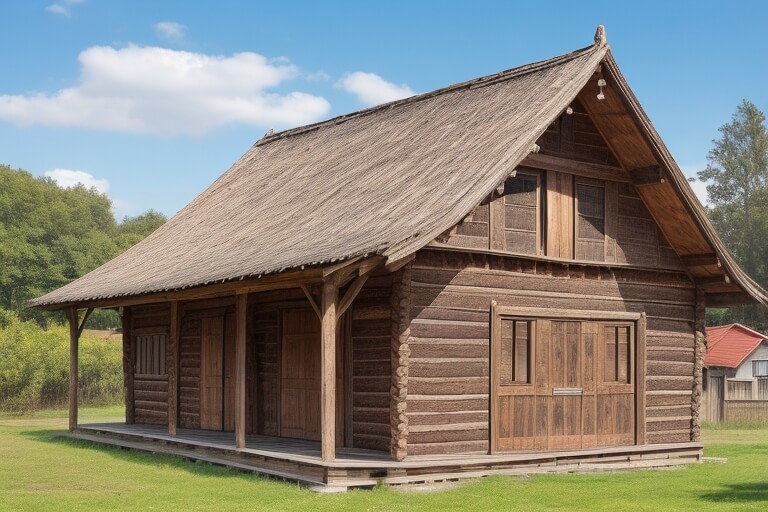Wood has long been the cornerstone of construction, playing a pivotal role in building shelters and structures that provide comfort and protection. The utilization of timber from local forests has been a timeless practice, with artisans and builders relying on its strength, durability, and accessibility.
In rural areas, log cabins are emblematic of wood’s traditional role in construction. The practice of using locally sourced timber for log cabin construction not only embraced the abundance of wood but also minimized transportation costs and environmental impact.
The construction of log cabins, in particular, is a testament to the artistry and ingenuity of early builders. The interlocking design of logs not only provided structural integrity but also excellent insulation, keeping inhabitants warm in harsh winters and cool in scorching summers.
Local forests have contributed to crafting intricate wooden bridges, barns, and fences. The sustainability of using wood from nearby forests has been a key factor in maintaining the charm of rural landscapes while reducing the carbon footprint associated with transporting materials over long distances.
Barns, for instance, have been essential structures in agricultural communities. Built from locally sourced timber, these barns have provided shelter to livestock and storage for crops, showcasing the versatility of wood in serving the agricultural needs of communities. Similarly, wooden fences, often handcrafted by local artisans, have delineated property boundaries and safeguarded fields and livestock.
Artisanal Craftsmanship
 Wood from local forests has been a prized medium for artisanal craftsmanship, inspiring a wide range of traditional skills and trades. These artisans have harnessed the beauty and malleability of wood to create functional and decorative items that reflect both their skills and the cultural heritage of their communities.
Wood from local forests has been a prized medium for artisanal craftsmanship, inspiring a wide range of traditional skills and trades. These artisans have harnessed the beauty and malleability of wood to create functional and decorative items that reflect both their skills and the cultural heritage of their communities.
Traditional furniture making is one such craft that has thrived thanks to the availability of local wood. Skilled craftsmen utilize their intimate knowledge of wood’s characteristics to fashion timeless pieces that showcase the natural grain and textures of the material. Chairs, tables, and cabinets, crafted from local wood, not only serve utilitarian purposes but also embody the artistry and cultural identity of the region.
One remarkable aspect of traditional woodworking is the meticulous attention to detail that artisans bring to their creations. Each piece of furniture is often crafted by hand, using time-honored techniques that have been passed down through generations. The result is furniture that not only serves practical functions but also stands as a work of art in its own right, with intricate joinery and decorative elements that reflect the personality and creativity of the craftsman.
Wood carving, too, has a rich history rooted in local forests. Artisans transform blocks of wood into intricate designs, ranging from figurines to ornate architectural details. These carvings are not just decorative; they are imbued with cultural significance, representing the artistic heritage of the region. Wood carvers often draw inspiration from nature, crafting delicate leaves, flowers, and animals that capture the essence of their surroundings.
In some communities, wood carving has been used to create religious artifacts and totems, adding a spiritual dimension to the craft. The process of carving, which can be meditative and labor-intensive, reflects the deep connection between the artisan, the material, and the culture they seek to preserve.
Woodturning is another form of artisanal craftsmanship where wooden objects are shaped by being rotated on a lathe. This technique is used to create items like bowls, vases, and intricate wooden spindles for furniture.
Fuel and Energy
The traditional use of wood as a source of fuel and energy is deeply rooted in human history, providing warmth, sustenance, and power to countless communities. The practice of sourcing wood from local forests for these purposes has been a testament to our ability to harness nature’s resources sustainably.
Wood stoves and fireplaces have played central roles in keeping homes warm during chilly winters. The simple yet ingenious design of wood-burning stoves allows for the efficient combustion of wood, emitting both radiant heat and a cozy ambiance. The act of gathering firewood from local forests has been a seasonal ritual in many communities, fostering a strong connection between people and the land they inhabit.
The use of wood for heating extends beyond residential spaces. In rural areas, wood-fired ovens have been essential for baking bread and preparing meals. The slow-burning, steady heat provided by wood ensures that food is cooked evenly and retains its distinctive flavors.
Wood has been a source of energy for various industrial processes. Historically, waterwheels turned by streams and rivers harnessed the energy generated from burning wood to power machinery. This practice allowed early factories and mills to produce textiles, grain, and other goods that were crucial for the economic development of regions.
In addition to its use as a source of heat and energy, wood has played a role in the production of charcoal. Charcoal, derived from the slow pyrolysis of wood, has been a vital fuel for blacksmiths and metalworkers. Its high heat content and consistency have made it an indispensable tool for shaping and forging metals, contributing to the development of tools, weapons, and machinery.
While modern energy sources have largely replaced wood as the primary source of fuel, the traditional practice of using wood from local forests for heating and energy generation remains relevant in many regions. Its sustainability, affordability, and connection to local ecosystems make it a valuable resource, particularly in areas where other fuel sources may be scarce or expensive.
Transportation and Infrastructure
Wood has been integral to the development of transportation and infrastructure, particularly in regions with abundant forests. Before the advent of modern materials like steel and concrete, wood was a fundamental resource for crafting boats, carts, and bridges, facilitating the movement of people and goods and connecting communities.
 Wooden boats, often constructed from locally sourced timber, hold a prominent place in maritime history. These vessels range from small fishing boats to larger cargo ships. Their construction involved an intricate knowledge of wood selection, shaping, and sealing techniques to ensure they could withstand the rigors of the sea. These vessels have served as lifelines for coastal communities, enabling fishing, trade, and transportation of goods along waterways.
Wooden boats, often constructed from locally sourced timber, hold a prominent place in maritime history. These vessels range from small fishing boats to larger cargo ships. Their construction involved an intricate knowledge of wood selection, shaping, and sealing techniques to ensure they could withstand the rigors of the sea. These vessels have served as lifelines for coastal communities, enabling fishing, trade, and transportation of goods along waterways.
In regions with rivers and streams, wooden riverboats and canoes have been invaluable for inland transportation. Carved from logs found in local forests, these boats provided essential connections between communities separated by waterways, fostering trade and cultural exchange. The versatility of wood allowed boat builders to create vessels suitable for various water conditions, from serene lakes to turbulent rivers.
Wooden bridges have also played a crucial role in connecting communities. Before the advent of steel and concrete, wood was the primary material for bridge construction. These wooden structures, built with expertise and craftsmanship, allowed for safe passage across rivers and ravines. In many rural areas, wooden covered bridges became iconic landmarks, combining functionality with a touch of architectural beauty.
The durability of wooden bridges is a testament to the resilience of wood when exposed to the elements. In some regions, these historic wooden bridges have been carefully preserved and restored, serving as both functional structures and reminders of the past.
Wooden carts and wagons, often hewn from local timber, were essential for overland transportation. These vehicles carried goods, people, and supplies, facilitating trade and communication between towns and villages. The adaptability of wood allowed for the construction of carts that could navigate uneven terrain, from rugged mountain paths to muddy rural roads.